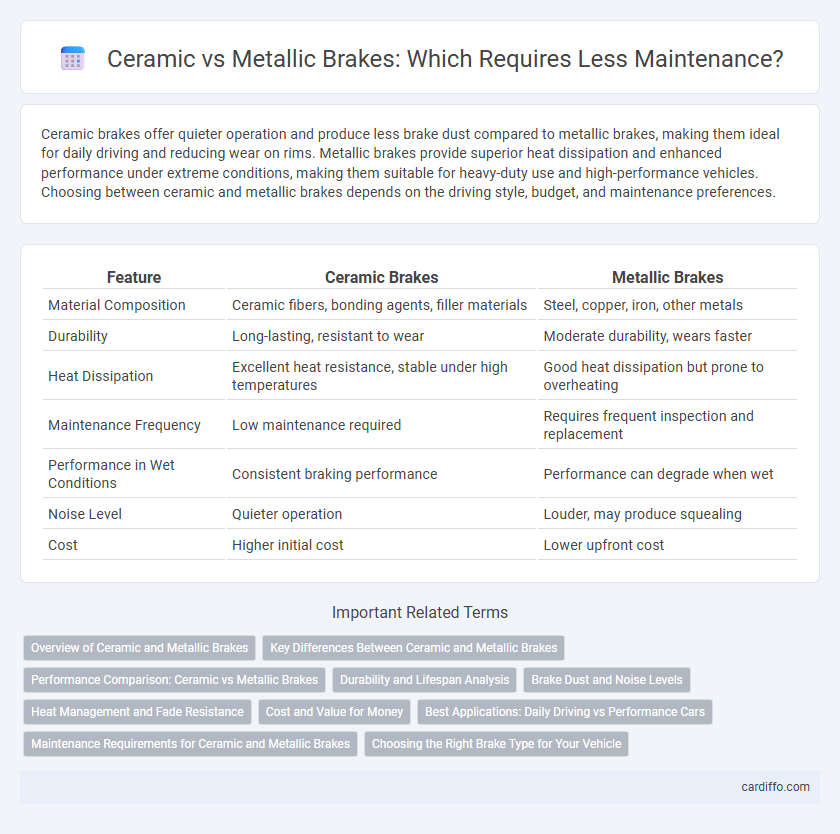Ceramic brakes offer quieter operation and produce less brake dust compared to metallic brakes, making them ideal for daily driving and reducing wear on rims. Metallic brakes provide superior heat dissipation and enhanced performance under extreme conditions, making them suitable for heavy-duty use and high-performance vehicles. Choosing between ceramic and metallic brakes depends on the driving style, budget, and maintenance preferences.
Table of Comparison
| Feature | Ceramic Brakes | Metallic Brakes |
|---|---|---|
| Material Composition | Ceramic fibers, bonding agents, filler materials | Steel, copper, iron, other metals |
| Durability | Long-lasting, resistant to wear | Moderate durability, wears faster |
| Heat Dissipation | Excellent heat resistance, stable under high temperatures | Good heat dissipation but prone to overheating |
| Maintenance Frequency | Low maintenance required | Requires frequent inspection and replacement |
| Performance in Wet Conditions | Consistent braking performance | Performance can degrade when wet |
| Noise Level | Quieter operation | Louder, may produce squealing |
| Cost | Higher initial cost | Lower upfront cost |
Overview of Ceramic and Metallic Brakes
Ceramic brakes consist of ceramic fibers embedded in a matrix, offering superior heat resistance and reduced brake dust compared to metallic brakes, which use metal compounds like steel and copper to provide strong performance and durability under heavy use. Ceramic brakes excel in quieter operation and longer pad life, making them ideal for daily driving, while metallic brakes deliver enhanced stopping power and better performance in extreme conditions such as towing or racing. Maintenance of ceramic brakes typically involves less frequent servicing, whereas metallic brakes may require more regular inspection due to increased wear and potential rotor damage.
Key Differences Between Ceramic and Metallic Brakes
Ceramic brakes feature brake pads made from ceramic fibers, bonding agents, and small amounts of metal, offering quieter operation, less brake dust, and longer lifespan compared to metallic brakes. Metallic brakes, using steel fibers and other metals, provide superior heat dissipation and increased stopping power, making them ideal for high-performance and heavy-duty applications. The key difference lies in ceramic brakes' ability to maintain consistent performance with minimal wear, while metallic brakes excel in durability under extreme conditions but generate more noise and dust.
Performance Comparison: Ceramic vs Metallic Brakes
Ceramic brakes offer superior heat dissipation and generate less brake dust compared to metallic brakes, resulting in longer component life and cleaner wheels. Metallic brakes provide better initial bite and are more effective under extreme conditions, making them ideal for high-performance or heavy-duty vehicles. Both types require regular inspection, but ceramic brakes tend to maintain consistent performance with less wear over time.
Durability and Lifespan Analysis
Ceramic brakes exhibit superior durability due to their resistance to heat and wear, often lasting 30% to 50% longer than metallic brakes under regular driving conditions. Metallic brakes, while offering strong initial stopping power, tend to wear faster because of higher friction and thermal stress, resulting in more frequent replacements. The enhanced lifespan of ceramic brake pads reduces maintenance intervals and overall replacement costs, making them ideal for drivers prioritizing long-term reliability.
Brake Dust and Noise Levels
Ceramic brakes produce significantly less brake dust compared to metallic brakes, which helps maintain cleaner wheels and reduces maintenance time. Noise levels from ceramic brakes are generally lower, offering quieter braking performance ideal for everyday driving. In contrast, metallic brakes tend to generate more brake dust and produce louder noise, which can contribute to more frequent cleaning and potential discomfort.
Heat Management and Fade Resistance
Ceramic brakes offer superior heat dissipation due to their material composition, reducing the risk of overheating during intense braking. Metallic brakes, while durable, tend to retain more heat, increasing the likelihood of brake fade under high-stress conditions. Heat management in ceramic brakes enhances fade resistance, providing consistent performance in demanding driving scenarios.
Cost and Value for Money
Ceramic brakes typically cost more upfront but offer longer lifespan and quieter operation, making them a cost-effective choice for long-term use. Metallic brakes are generally cheaper initially but wear out faster and produce more noise, leading to more frequent replacements and higher maintenance costs. Evaluating total cost of ownership, ceramic brakes provide superior value for money through durability and reduced maintenance frequency.
Best Applications: Daily Driving vs Performance Cars
Ceramic brakes offer superior heat resistance and reduced brake dust, making them ideal for daily driving where longevity and low maintenance are priorities. Metallic brakes provide enhanced stopping power and durability under extreme conditions, suited for performance cars requiring aggressive braking during high-speed and track use. Choosing the right brake type optimizes vehicle safety and maintenance intervals based on driving demands.
Maintenance Requirements for Ceramic and Metallic Brakes
Ceramic brakes require less frequent maintenance compared to metallic brakes due to their resistance to wear and heat, resulting in longer pad lifespan and reduced rotor damage. Metallic brakes, while offering better initial stopping power and heat dissipation, demand regular inspection and replacement of pads and rotors as they wear faster and produce more brake dust. Proper maintenance schedules for ceramic brakes typically extend beyond 70,000 miles, whereas metallic brakes may require servicing every 30,000 to 50,000 miles depending on driving conditions.
Choosing the Right Brake Type for Your Vehicle
Ceramic brakes offer superior performance with less noise and dust, making them ideal for everyday driving and lighter vehicles, whereas metallic brakes provide enhanced durability and heat dissipation suited for heavy-duty applications and high-performance vehicles. Selecting the right brake type depends on driving conditions, vehicle weight, and maintenance preferences; ceramic pads are optimal for quieter, low-wear operation, while metallic pads excel under extreme braking and heavy loads. Consider vehicle manufacturer recommendations and your driving style to maintain safety and maximize brake lifespan.
Ceramic Brakes vs Metallic Brakes Infographic

 cardiffo.com
cardiffo.com